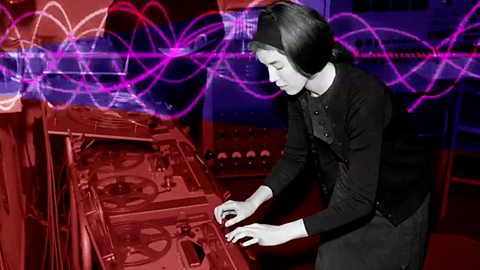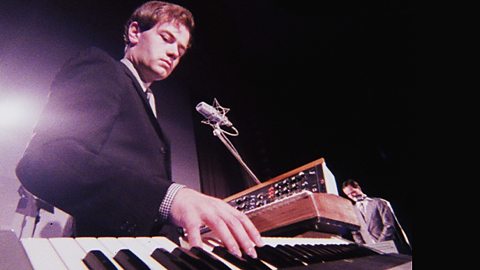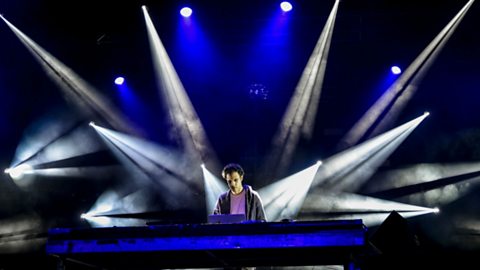A tribute to the synth: how synthesisers revolutionised modern music
By Emma Finamore, 14 September 2018

Synthesisers may be synonymous with 80s pop, but - as you can hear in Stuart Maconie’s Freak Zone synth special - the influence of these powerful musical machines extend much further than that.
The humble synth has shaped a wide range of musical forms, and has had a massive impact on the worlds of TV and film too. In fact, without the invention of the synthesiser, the modern world would look - and sound - a whole lot different. Here, we take a look at the many ways that synths have shaped the music we hear today.
The early beginnings...
First, a quick history lesson. As we hear in The Great Bleep Forward (a four-part series on electronic music, presented by Andrew Collins, available to listen to now) the synth dates back to the 1800s. Many regard the Telharmonium, an electrical organ developed by Thaddeus Cahill in New York during the 1890s, to be an early predecessor of the synthesiser. However, the Telharmonium came with its fair share of problems, for example, it "weighed so much and took so much energy from the New York grid".
Fast-forward to the 1920s and Russian scientist Leon Theremin gave his name to a revolutionary electronic musical instrument that could be played without being touched. The Theremin was even once played by Communist leader Vladimir Lenin, and the instrument's eerie sound was later used in films like Alfred Hitchcock's Spellbound and sci-fi classics such as The Day the Earth Stood Still. Meanwhile, in pop music, an Electro-Theremin was famously used in The Beach Boys' track Good Vibrations.
During the 1970s, manufacturers like Moog, Korg and Yamaha introduced analogue synthesisers to the mainstream market, and this was when synths really hit their stride. Engineer Bob Moog (who built his first Theremin at 14) met experimental composer Herbert Deutsch, which led to the creation of his pioneering prototype: the Moog Modular Synthesiser. "It was a bit like slipping backwards on a banana peel," said Moog of his exploration of sound.
The influence of Daphne Oram and Delia Derbyshire
Experiments in sound were a key part of developing the synth, and two women at the BBC were at the forefront of this exploration. From the 1940s, Daphne Oram - co-founder of the BBC Radiophonic Workshop – used tape recorders and electronic oscillators to find new sounds beyond conventional methods, airing her findings on television and radio. A true visionary, Oram once said she wanted computer-like machines to be "an extension of the arm of the composer." Oram’s early experiments at the Radiophonic Workshop would change how music was made for TV forever, and her experimentation - and unfinished Oramics System prototype - foreshadowed the synthesiser.
Later, Delia Derbyshire – a mathematician and musician – continued what Oram had started at the BBC, famously composing the Doctor Who theme that continues to be adapted and reworked today. The TV and radio theme tunes created by Oram and Derbyshire primed the ears of the nation for electronic music and paved the way for future artists.

Daphne Oram and Delia Derbyshire - electronic music pioneers
The story of Daphne Oram and Delia Derbyshire, the women who pioneered electronic music
When synths infiltrated the mainstream
Many cite Wendy Carlos' Switched-On Bach (1968) as the first popular album to incorporate synthesisers, which had been confined to use by experimental artists until that point. The record saw Carlos perform pieces by Johann Sebastian Bach on Moog modular synthesiser, showing the potential of machines in music-making. It was this point that the wider public realised that the synthesiser was a device that could be used to make "real" music.
It was the decade that followed, though, which saw synths really embraced by bonafide musicians. Synthesisers were central to the development of electronic bands and artists in 1970s Germany – Kraftwerk and Tangerine Dream, for example, used them to make an entirely new sound. In 1974, synths helped Kraftwerk recreate the sounds of the trucks, cars, and passing bridges heard while driving through Germany, on their track Autobahn. Meanwhile in the UK, Brian Eno’s 70s and 80s output was heavily inspired by the Minimoog synth, first released in 1970.
From these experimentations came the synth-pop era, which peaked in the late 1970s to mid-1980s, a period that saw synths truly embraced by the mainstream. Electronic acts including The Human League, Ultravox and Gary Numan combined futuristic sounds with pop hooks, dominated the charts in the process. Without these artists and their new wave peers, popular music wouldn't sound as bold and vibrant as it does today. Their influence can still be seen in some of today's more retro-leaning acts, like La Roux, CHVRCHES and even the early music of Lady Gaga.

Kraftwerk appear on Tomorrow's World
Kraftwerk's 1975 British TV debut, demonstrating Autobahn's “machinemusik"
Beyond synth-pop...
Synths haven’t just influenced synth-pop though; the instrument has been utilised by artists of many genres - from prog-rock and soul to hip hop and grime.
Rick Wakeman of Yes famously loved the MiniMoog – sometimes using 30 keyboards on stage at once – while Pink Floyd’s Dark Side of the Moon riff was made by a sequencer on the EMS VCS3 synth. Meanwhile, a 21-year-old Stevie Wonder - looking for new ways to make his music – met synth pioneers Tonto’s Expanding Head Band in the early 70s, and it was the meeting of very different musical minds. On The Great Bleep Forward, Malcolm Cecil, one half of the duo, reveals: "Once we introduced [Wonder] to the synthesiser it was like the tapping of a well – all these songs would come flowing right out of him."
Synths have long shaped hip hop too, with samples – usually lifted from funk and disco tracks – ultilised by DJs and producers. Minimoog fans Parliament, for example, have been sampled by everyone from Snoop Dogg to De La Soul. Kanye West, meanwhile, even has an album named in part after a type of synth.
Like hip hop, grime has often incorporated (frequently the more raw and brash) synth sounds, with many early grime acts using the FruityLoops programme, a MIDI-only step sequencer and early software synthesiser. It was simple and easy to use and influenced grime’s instantly-recognisable ‘magic number’ of 140 bpm – the preset tempo in FruityLoops.
We have synths to thank for the sound of TV and film
Oram and Derbyshire revolutionised TV soundtracks with the use of synths, and the instrumental continues to be vital for film and television scores today. The original Star Trek theme featured the Ondes Martenot – whose eerie sound is often mistaken for a woman’s voice – and synths have been used to create atmospheric themes for shows like Knight Rider, Twin Peaks and, more recently, Stranger Things.
The big screen has also harnessed the power of synths. In the 70s and 80s, compelling synth sounds were used to score everything from sci-fis and thrillers to horror films, such as A Clockwork Orange, Apocalypse Now, The Fog and Manhunter. In recent times, Cliff Martinez used synths to bring a dark ambience to Drive and Solaris.
Nine Inch Nails' Trent Reznor – who composed the scores for The Social Network, The Girl with the Dragon Tattoo, Gone Girl and other movies alongside Atticus Ross – has spoken about the human, organic quality of synths, telling Lauren Laverne that film scores involved "studying emotions and how to get them to translate."
Synths - and computers - continue to move things forward
Synths still continue to be used in great and groundbreaking ways. Last year Japanese sound artist Ryoji Ikeda built a synth orchestra out of one hundred cars, transforming an open air car park into an automobile symphony. Ikeda used the frequency emitted by each car (and unique to each vehicle), played through tone generators, to create something totally new. "It’s very complicated. We call it the ‘largest synthesiser’," Ikeda said at the time. "One hundred oscillators! No synthesiser has one hundred oscillators."
Old analogue synths are being used to create contemporary sounds, too. Critically-acclaimed electronic musician Floating Points, for example, uses his Buchla synthesiser to make dance music with a classical edge. Then there’s the new ‘pocket synths’, a core part of synthwave – a subgenre of synth-pop that emerged in the mid-2000s. Acts like Electric Youth and Mitch Murder have been putting a contemporary, synth-heavy spin on '80s pop culture – particularly creating soundtracks for movies, television and video games.
These days though, computers can be seen as picking up the gauntlet from the synth, using algorithms and AI to further explore possibilities in electronic music. A recent experiment, backed by Google, combined music with artificial intelligence, with AI Duet acting as a virtual pianist that can respond to notes played by users and accompany them in a duet. Rather than being built around a set of pre-programmed musical rules, the groundbreaking experiment uses a neural network ‘trained’ by machine learning – using its own knowledge of musical examples built up over time.
It may be 2018, but synths and synth-inspired software are still managing to break new ground. Long may it continue.

Four Tet: Highlights from Glastonbury 2014
Four Tet appeared on the Park Stage on 27th June 2014.
Follow us on Facebook, on Twitter @BBC6Music, or on Instagram @BBC6Music.









